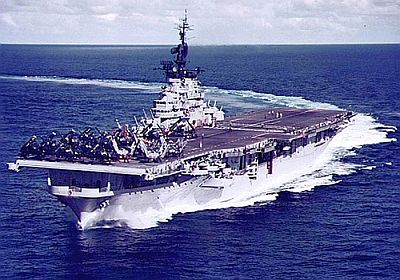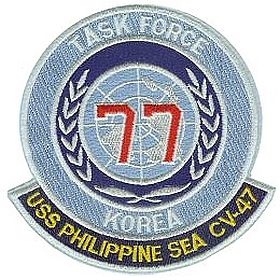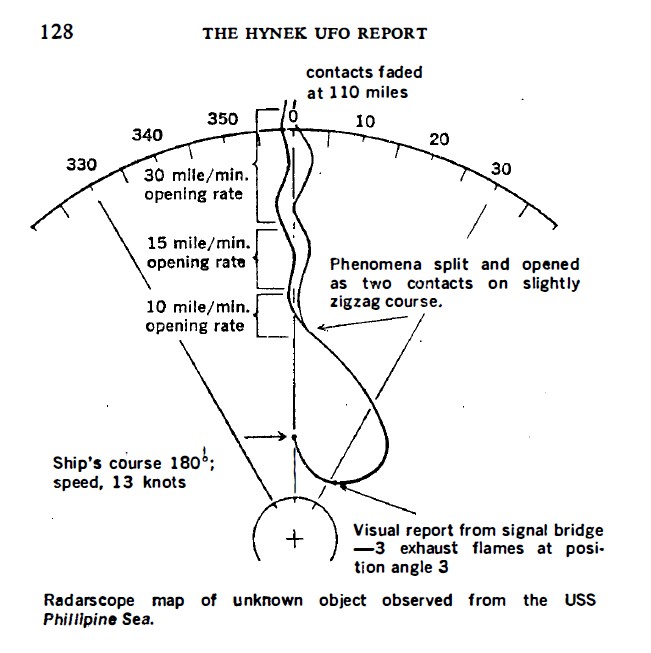

Dr. J. Allen Hynek summarized the February 2, 1952 radar-visual report in his book THE HYNEK UFO REPORT starting on page 128. The book is available online at the Center for UFO Studies (CUFOS).
Hynek considered two intelligence reports detailing these UFO radar/visual incidents, one covering the period April-May 1951, and the other February 2, 1952. He was unaware that according to a retired Navy Commander, who served as a Lieutenant on the USS Philippine Sea during 1952, the US Navy had additional UFO encounters in the Korean war zone.
Hynek did have in his possession the Navy documents on the February 1952 incident involving the USS Philippine Sea, which are no longer in the Project Blue Book file nor are they even accounted for as a “missing case.” Using these documents he summarized the event in a much easier to follow format as opposed to the dry and sometimes cryptic military jargon found in the official reports.
 |
 |
One of the longest series of military radar sightings took place in and around the Korean War zone over a period of fifteen months from January 1951 to April 1952. These cases involved just about every type of radar sighting, from single-radar contact with a UFO to multiple radar-visual contacts, both in the air and on board naval vessels. Some twenty-four cases were involved and according to Air Intelligence Information Reports in the Project Blue Book files, "The majority of the reports remain unexplained from the limited information available."
These reports, accompanied by charts indicating the flight paths of the UFOs involved, provide some of the most interesting reading in the Blue Book files. Summarized below are some of the highlights: On February 2, 1952, radar operators aboard the aircraft carrier Philippine Sea picked up an unidentified high-speed UFO off the east coast of Korea. The object was first detected at a distance of twenty-five miles and when it closed to twenty miles it made a wide turn to the east, opening to a course directly away from the carrier.
As excerpted from a message to the Commander Naval Forces Far East sent by the Philippine Sea, the report on the speed and unusual separation into two objects of this UFO contact stated: "Measured speed 10 miles per-minute (600 MPH) for first minute, 15 miles per minute (900 MPH) for second minute, 30 miles per minute (1800 MPH) for third minute. Opened as 2 contacts 5 to 12 miles apart."
Three signal observers on the deck of the Philippine Sea also sighted the UFO visually and reported independently to the bridge that they could detect three exhaust flames. The observers stated that the trail appeared to them as aircraft exhaust during the time the object reversed its course. However, no aircraft at that time was capable of the incredible speeds attained by the UFO and no conventional aircraft were reported in the area. The position of the object, sighted at seventeen miles from the carrier, was also held on the radar scope at that time. The estimated altitude of the object was 52,000 feet and it faded from the radar scope at 110 miles. During the time it was in view, the coast of Korea and the island of Ullung Do were visible at a distance of twenty miles, and an escorting destroyer was visible on the scope 2,000 yards from the carrier. The comment of the intelligence officer who prepared the report on this case was as follows:
A thorough debriefing was made of the radar operator. Personnel stated that 'the operator was very intelligent, efficient and cooperative. Operator was cognizant of capabilities and limitations of the radar equipment and made careful plots, checking constantly. At time contact was closing, he queried the aircraft controller and when it was determined that it was not a friendly aircraft, the general alarm was sounded. The three minutes of careful plotting were made after the object had turned and was heading away from the station. Operator was sure of the accuracy of the plots for the three minutes, and was adamant that the speeds shown were approximately correct.

A letter classified SECRET was sent on April 8, 1952, by the Commander Naval Forces, Far East, to the Chief of Naval Operations, enclosing a track chart of the UFO in question and stating, in part: "Enclosure (1) is forwarded for information and evaluation. This is probably the first instance of a visual and radar contact on a high speed aerial target being made simultaneously in the Far East."
Martin Shough analyzed this case based on Hynek’s account above. See:
NARCAP TR - 6 Date of Report: 12-02 which is taken from:
RADCAT :
Radar Catalogue: A Review of Twenty One Ground and
Airborne Radar
UAP Contact Reports Generally Related to Aviation
Safety for the Period October 15, 1948 to September 19, 1976
|
||||||||||||
PRECIS: The aircraft carrier USS Philippine Sea was making 13 knots on a 180-degree (S) heading off the E coast of Korea. A single target was detected on radar at 0 degrees (N) range 25 miles approaching the ship. At range 20 miles the target began a wide turn to the E, radius 11-12 miles. The radar operator queried the aircraft controller for an ID of the target. At this point three signal observers on deck independently reported visual sightings to the bridge of an object or objects resembling three "exhaust flames" at 30 degrees elevation and turning away from the ship at the same azimuth as the radar target, which at this time was shown at an altitude of 52,000', range 17 miles and increasing. The aircraft controller determined that the target was not a friendly aircraft, and the general alarm was sounded. The target continued to turn away onto a heading approximately NW until it returned to a 0-degree bearing from the carrier, range now 55 miles, where it split and opened as 2 contacts several miles apart. At this point the radar operator began to make "careful plots, checking constantly" for 3 minutes while the 2 targets headed N abreast on a slightly zigzag course, fading from the scope at range 110 miles. During this period the targets accelerated:
"Measured speed 10 miles per minute (600 mph) for first minute, 15 miles per minute (900 mph) for second minute, 30 miles per minute (1800 mph) for third minute."
NOTES: According to Hynek's commentary on the intelligence report: "During the time it was in view, the coast of Korea and the island of Ullung Do were visible at a distance of twenty miles, and an escorting destroyer was visible on the scope 2,000 yards from the carrier." Presumably this means that the coast and island were both seen on radar, rather than visually, although this is unclear. But it should be noted that Ullung Do is some 80 miles from the nearest point on the coast of South Korea at Ulchin, so that at no time could the ship have been 20 miles from both. However this inconsistency is probably an introduced error, and should not be taken to signify any extraordinary propagation conditions.
The radarscope map of the incident is consistent with all speeds, ranges and azimuths cited. It should also be emphasised that independent visual observers estimated the elevation of the "exhaust flames" as 30 degrees when turning past the ship, whilst radar at this point showed the target at 17 miles (slant) range, altitude 52,000', or almost exactly 30 degrees. It is worth noting that at this point it would be irrational to conclude that the target was anything other than aircraft, and if the incident had ended there no "UFO" report would have been submitted. Even the separation of the target would not of itself challenge this conclusion, since more than one aircraft flying within the resolution cell could be displayed as a single echo, and the three "exhaust flames" could be said to confirm this interpretation.
However, the rather careful plotting of speeds up to 1800 mph instantly changes the complexion of the incident, and once it has become a "UFO report" it invites us to attempt all manner of contorted interpretations. The question in a case such as this is whether the a priori improbability of a "UFO" (whatever that might mean) outweighs the prima facie probability that a target consistently tracked on radar and confirmed visually was physically present. This question is not answerable in practice. Suffice it to say that the radar incident has no easy explanation in terms of super-refractive AP of sea clutter or surface ships, partial inversion reflection, CAT, birds, insects, balloons or other wind borne objects, side lobe returns, multiple-trip returns from targets beyond the unambiguous range, spurious internal signals or RFI. A "ghost" echo from an efficient surface reflector (say, the angle made by the side of a ship with the sea – a destroyer was in the vicinity) received via an aircraft as primary reflector might achieve the speeds reported, but: a) no such aircraft, which must ex hypothesi have been within the radiation pattern, was separately detected, and no known aircraft were reported to be in the area; and b) a total radar duration on the order of 10 minutes and a track painted continuously to a range of 110 miles makes any ghost reflection involving a ship only ? mile away extremely improbable. (A ghost reflection with the ship as primary reflector could not achieve the >45 degrees change in azimuth reported, being displayed always on the ship's true azimuth.)
http://narcap.org/reports/TR6pt1.htm
20l2016 NATIONAL AVIATION REPORTING CENTER ON ANOMALOUS PHENOMENA
The target behavior appears to have been rational and consistent, without erratic jumps, disappearances or course-reversals, executing a smooth turn with a radius of some 12 miles in the manner of an aircraft, though at somewhat high altitude. Together with multiple independent visual sightings at a position consistent with the concurrent radar target, it is reasonable to conclude that the incident was most probably caused by a real radar-reflective object or objects emitting light resembling that from an aircraft exhaust. However no aircraft in 1952 was remotely capable of speeds up to 1800 mph, and this is the crux of the case: if the displayed speed can be explained then the object(s) can be explained as probable aircraft.
The intelligence report has this to say, pertinent to the possibility of operator error:
A thorough debriefing was made of the radar operator. Personnel stated that the operator was very intelligent, efficient and cooperative. Operator was cognizant of capabilities and limitations of the radar equipment ....The three minutes of careful plotting were made after the object had turned and was heading away from the station. Operator was sure of the accuracy of the plots for the three minutes, and was adamant that the speeds shown were approximately correct.
The likelihood of gross malfunction in the radar display(s) would appear to be minimised by the very close match with the visual azimuth and elevation reported as the target turned past the ship. It is conceivable, however, that there was a range-scale error on the PPL If, for example, a selected range-scale of 100 miles was actually giving a 30-mile scale due to electromechanical fault, and if the operator failed to notice the error, then there would be a factor-three error in plotted ranges, leading to a true maximum speed on the order of 600mph during the final 60 seconds of the track – roughly the maximum speed of, say, an F-94 in a powered descent. Angular position and motion would of course be preserved.
This hypothesis is highly speculative and, it must be said, not particularly plausible. It is first of all unlikely that an operator with the stated experience would neglect to notice so basic a fault during or after the ten minutes or so of the event whilst making "careful plots, checking constantly", evidently cognisant of the abnormal nature of the track, and the (presumably known) position of the escort destroyer — concurrently displayed at 2000 yards from the carrier — would have been an unmissable and constant reference datum on-scope long before and long after the appearance of the target, not to mention the coasts of Korea and Ullong Do island. (The aforementioned ambiguity in the stated range of these land echoes is unfortunately not relevant to this hypothesis, since: a) if there is an original error here it is in the wrong direction - that is, the displayed range would be exaggerated by 3 to 120 miles, not reduced to 20 miles; and b) it is anyway much more likely that this is a constructional error in Hynek's case summary, the figure of 20 miles referring either to the mainland or to Ullong Do, clearly not to both.)
In conclusion there appears to be no reasonable explanation of the object(s) observed.
STATUS: Unknown
Phillip Robertson of Independent Aerial Phenomena Research (IAPR) also analyzed this event, again using details from Hynek's account.
[First radar contact] …radar on the U. S. S. Philippine Sea detected a return that indicated an object travelling 767 miles per hour. No visual observation was made.
[Second radar contact] …ten minutes after the above radar tracking, the same radar site detected a target seeming travelling 1257 miles per hour. Again, there was no visual observation.
[Third radar contact] …Nine hours after the last sighting, the same radar site again detected a high speed ‘object.’
In this case the target accelerated from 600 miles per hour (first minute of tracking) to 900 miles per hour (second minute of tracking) to 1800 miles per hour (third minute of tracking.) The return was initially detected at a range of 25 miles and was tracked to a range of 20 miles, where it made a wide turn to the east and opened as two targets 5 to 12 miles apart. Three signal bridge personnel independently observed three “exhaust flames” which appeared at or near the position plotted for the radar target at the time it executed its turn. Speed plots were made after “object” made the turn to the east.
This case leaves many questions unanswered – e.g. were the “exhaust flames” emanating from one object or were they seemingly coming from three separate objects? How close was the match between visual and radar “objects?” What were the exact weather conditions prevailing at the time of the observation?
(General meteorological conditions were: 10 miles visibility with 5/10ths cloud cover.) It should be noted that the acceleration of the radar target at departure followed a progression of multiples of 300. This may or may not have any significance. [Case is summarized in Dr. J. Allen Hynek's THE HYNEK UFO REPORT, Dell, 1977, pages 126-127.]
|
|
|
|
|